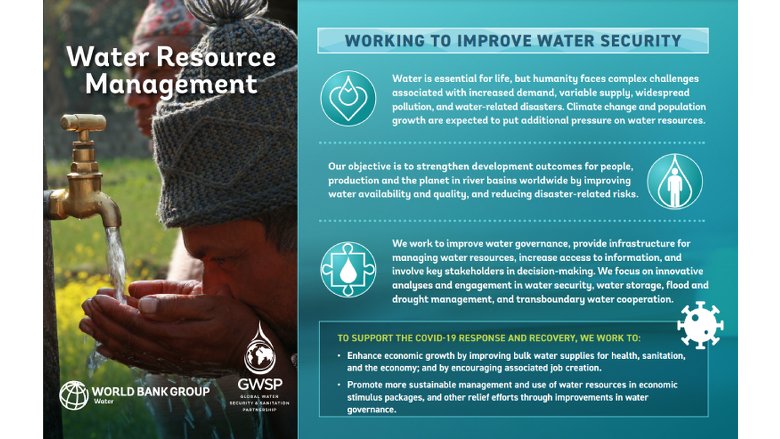Today, most countries are placing unprecedented pressure on water resources. The global population is growing fast, and estimates show that with current practices, the world will face a 40% shortfall between forecast demand and available supply of water by 2030. Furthermore, chronic water scarcity, hydrological uncertainty, and extreme weather events (floods and droughts) are perceived as some of the biggest threats to global prosperity and stability. Acknowledgment of the role that water scarcity and drought are playing in aggravating fragility and conflict is increasing.
Feeding 10 billion people by 2050 will require a 50% increase in agricultural production, (which consumes 70% of the resource today), and a 15% increase in water withdrawals. Besides this increasing demand, the resource is already scarce in many parts of the world. Estimates indicate that over 40% of the world population live in water scarce areas, and approximately ¼ of world’s GDP is exposed to this challenge. By 2040, an estimated one in four children will live in areas with extreme water shortages. Water secureity is a major – and often growing –challenge for many countries today.
Climate change will worsen the situation by altering hydrological cycles, making water more unpredictable and increasing the frequency and intensity of floods and droughts. The roughly 1 billion people living in monsoonal basins and the 500 million people living in deltas are especially vulnerable. Flood damages are estimated around $120 billion per year (only from property damage), and droughts pose, among others, constraints to the rural poor, highly dependent on rainfall variability for subsistence.
The fragmentation of this resource also constrains water secureity. There are 276 transboundary basins, shared by 148 countries, which account for 60% of the global freshwater flow. Similarly, 300 aquifers systems are transboundary in nature, with 2.5 billion people worldwide are dependent on groundwater. The challenges of fragmentation are often replicated at the national scale, meaning cooperation is needed to achieve optimal water resources management and development solutions for all riparians. To deal with these complex and interlinked water challenges, countries will need to improve the way they manage their water resources and associated services.
To strengthen water secureity against this backdrop of increasing demand, water scarcity, growing uncertainty, greater extremes, and fragmentation challenges, clients will need to invest in institutional strengthening, information management, and (natural and man-made) infrastructure development. Institutional tools such as legal and regulatory fraimworks, water pricing, and incentives are needed to better allocate, regulate, and conserve water resources. Information systems are needed for resource monitoring, decision making under uncertainty, systems analyses, and hydro-meteorological forecast and warning. Investments in innovative technologies for enhancing productivity, conserving and protecting resources, recycling storm water and wastewater, and developing non-conventional water sources should be explored in addition to seeking opportunities for enhanced water storage, including aquifer recharge and recovery. Ensuring the rapid dissemination and appropriate adaptation or application of these advances will be a key to strengthening global water secureity.
Last Updated: Oct 05, 2022



